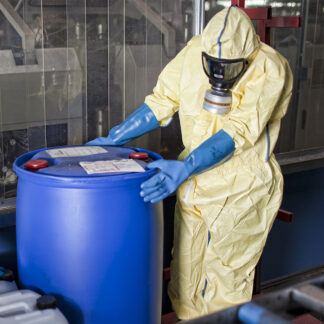Chemical Resistant Gloves
Hand injuries from chemical exposure can be easily preventable by wearing the proper chemical resistant gloves. However, there is no "one size fits all" type of chemical resistance when it comes to protecting your hands. Fortunately, you can call on the sales team at Liberty Safety to help you choose the best glove for your needs. Other factors to consider when choosing chemical resistant gloves Other factors to consider are the glove's physical characteristics, including thickness, length, finish, and linings.…
Hand injuries from chemical exposure can be easily preventable by wearing the proper chemical resistant gloves. However, there is no “one size fits all” type of chemical resistance when it comes to protecting your hands.
Fortunately, you can call on the sales team at Liberty Safety to help you choose the best glove for your needs.
Other factors to consider when choosing chemical resistant gloves
Other factors to consider are the glove’s physical characteristics, including thickness, length, finish, and linings.
Length
Depending on the job, you may need an extra splash or immersion protection, so you’ll want to consider gloves that are longer. LGS sells chemical resistant gloves that can be up to 22 inches long to cover more of the arm.
Thickness
Gloves made of thicker material tend to be heavier but offer better chemical resistance than their thinner counterparts. Thinner gloves, however, provide better flexibility and touch sensitivity but aren’t as protective against some chemicals.
Finishes and Linings
If you need a better grip, a textured finish is your best option. Softer knit or fabric linings are offered on several styles of gloves for comfort, perspiration absorption, and temperature protection.
Supported and Unsupported
Supported gloves provide an extra layer of support to the protective outer coating. They are often used for industrial chemical handling, detergent handling, farming, janitorial tasks, home general duty and gardening.
Unsupported gloves do not have a lining underneath and typically have a palm thickness ranging from 11 to 30 mil. They’re disposable gloves mainly used for work in oil industry, metal fabrication, food preparation, automotive, painting, household cleaning, and more.
Liberty Glove and Safety offers an excellent selection of supported and unsupported protection to choose from depending on your needs.
What industries need chemical resistant gloves?
Workers should use chemical resistant gloves when they handle any chemical they encounter, which means chemical resistant gloves are appropriate in most work environments.
OSHA’s Code for Federal regulations 29 (CFR) 1910.138 states that employers are responsible for ensuring that their employees use hand protection. 1910.138 (a), General Requirements specifically relates to chemical protection gloves, stating that the gloves have to protect against skin absorption of harmful substances, punctures, and chemical burns.
FAQ
It’s important to keep in mind when choosing gloves that some chemicals will damage your skin without protection. Those chemicals can even enter your bloodstream in the right conditions, causing real physical distress, which is why it’s essential to use the proper gloves.
OSHA recommends asking the following questions to help determine when and what chemical resistant glove may be necessary:
- What types of chemicals are being handled?
- What is the nature of contact? Is it total immersion or only splashes?
- What is the duration of contact?
- Is it just the hand that needs protecting, or the forearm and arm as well?
- What kind of grip is required?
After you identify the specific solvents, chemicals, or solutions that you’ll be exposed to, it’s time to select the type of material and glove model that is best to use.
Choosing the best glove for your workplace application means not just getting the size right but getting the protective material right too. The material used in your chemical resistant gloves must be appropriate for the process they are being used for. The job and the health of your skin depend on it.
After identifying the chemical hazards you’ll be exposed to, the next step is to consider how the glove material — or polymer — will stand up to it. Different glove materials offer varying degrees of protective properties, texture, flexibility, and thickness.
There are four most common types of chemical resistant materials that will protect against chemical hazards.
- Rubber (or latex) coated gloves resist bases, acids, alcohols, and diluted aqueous solutions of most types of chemicals. When used for gloves, it adds superior grip and cut resistance. Rubber-coated gloves are an excellent choice for handling ceramic, glass, and some sharp-edged products.
This material is very common and often used in less expensive protective gloves. It’s not known for high chemical exposure protection. Instead, it is mainly used to offer protection against bloodborne pathogens and is used frequently in the food industry.
Note that it also can create an allergic reaction in some people, so a skin test before use is a good idea.
- Nitrile is a perfect solution for oils, petroleum, and certain acids and caustics. It is sometimes also known as synthetic rubber. Additional abrasion resistance offers a non-slip grip and makes nitrile gloves a good choice for general-purpose use.
It’s a material used in a wide variety of gloves for many applications. Used in the oil and gas industry as well as the medical industry, the material is considered a mainstay of chemical-resistant glove construction.
Because they have poor flame resistance, it’s not recommended when using strong oxidizing acids or organic chemicals with nitrogen.
- Neoprene has similar basic chemical resistance qualities as nitrile but with less abrasion resistance. Depending on the application, both nitrile and neoprene are available in unsupported and coated (palm or fully coated).
Neoprene is known for excellent protection against certain acids and a broad range of other chemical hazards like alcohols, oils, and inks. It is also known for its flexibility and dexterity and therefore really holds up in work environments that need good sensitivity and grip.
However, gloves made from Neoprene material are not recommended around oxidizing acids like nitric or chromic acids.
- Polyvinyl Chloride (PVC) is the best choice for cost-effectiveness when protecting against chemicals, oils, and grease. This compound is the perfect choice for hand protection against petrochemicals, refining, and construction sites.
PVC is available in laminated (PVC sealed to a baseliner such as knit lining) or impregnated (PVC blends through a cotton or jersey liner).
You may already be familiar with PVC but instead, refer to it as plastic or vinyl. It offers durability and has good resistance to cuts and snags. It is an excellent choice for chemical and abrasion resistance where moisture is not a concern.
It’s not recommended to use with acetone or chlorinated type solvents because it can actually harden the material and make the glove challenging to use.
When choosing any PPE, the actual environment where you’ll be using it is the most significant consideration. Ask yourself what physical hazards will you be exposed to and what work needs to get done when wearing it?
Review the chemical resistant chart below to help you identify the material that’s best suited for the work you’ll be performing.



